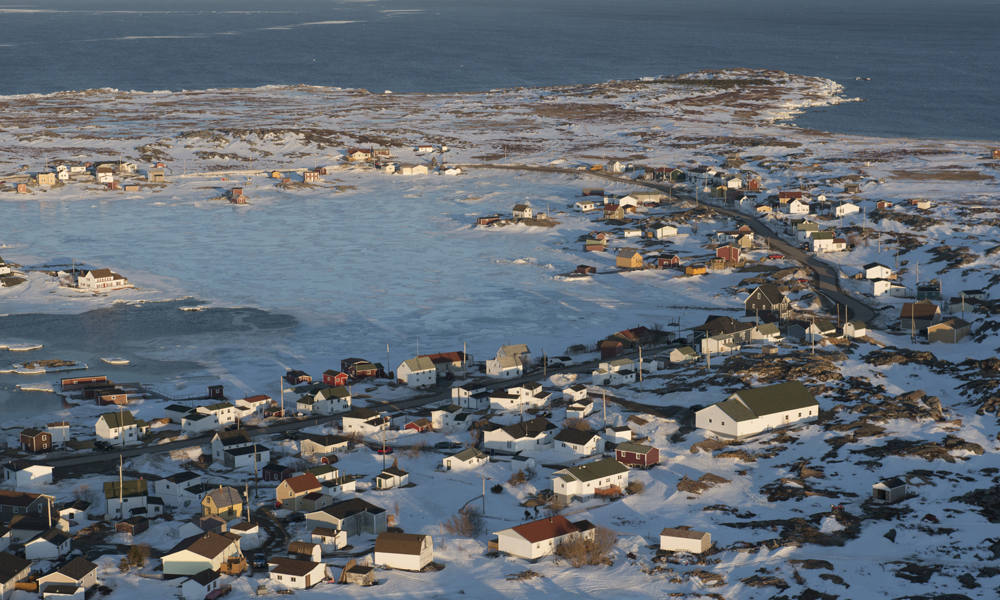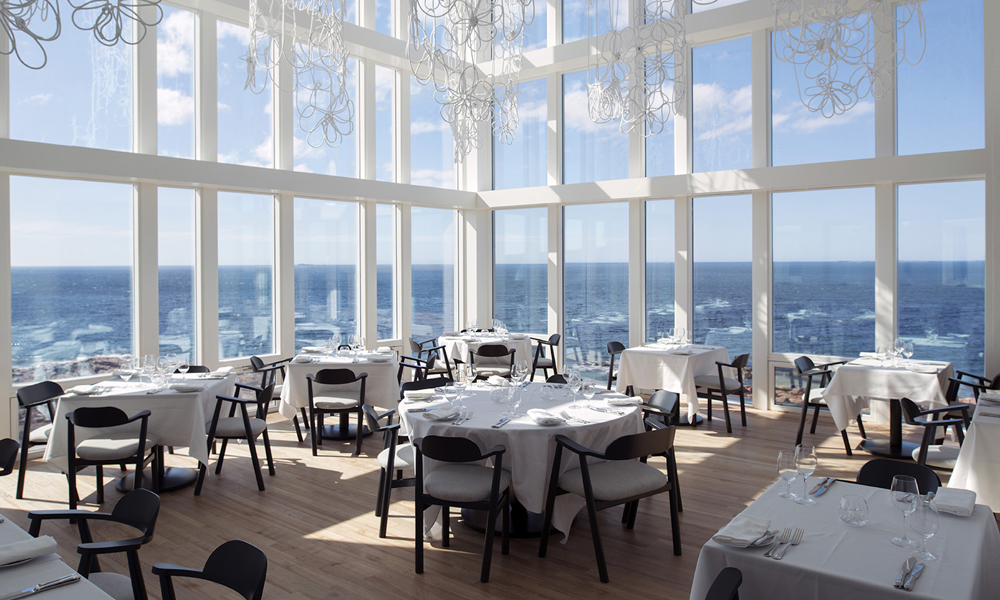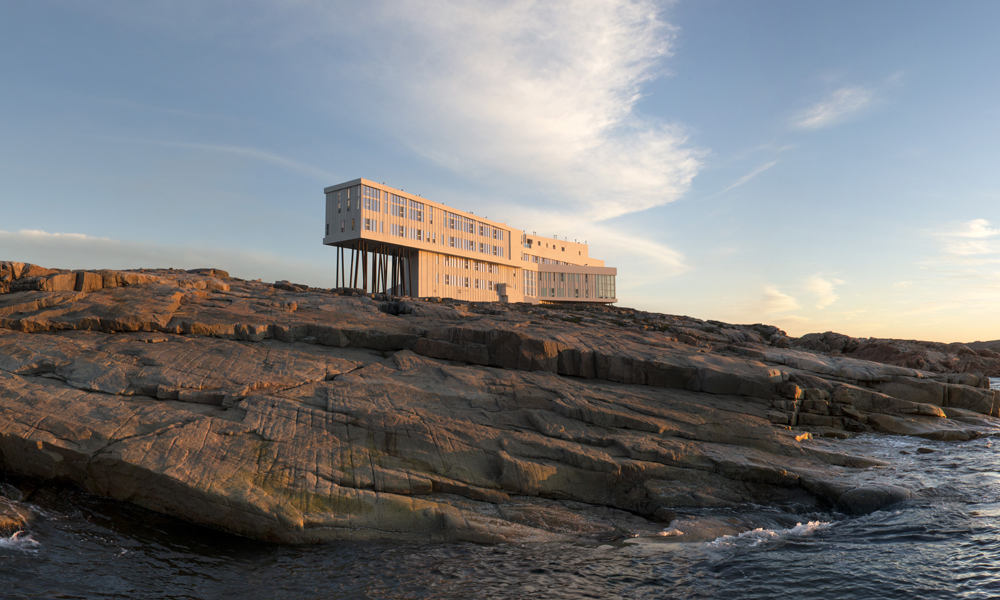Newfoundland and Labrador’s remote inn inspires lively story-telling, culinary reinvention and perfect, homespun hospitality…
By Doug Wallace
“We might not make it,” I say, as our car inches closer and closer to the Farewell Ferry gate, behind a line of motor homes and boats, even a semi heaped with a load of sod. As the next ferry is in three hours, our fingers cross tighter – and we squeeze into the last space. Smiles all around. “You should run out and buy a lottery ticket,” one of the ferry guys says.
We buy a coffee instead and drop a few dollars in the accordion player’s case, looking out towards our destination: the rocky shores of Fogo Island off the northeast coast of Newfoundland and Labrador.
We’re making the trek to experience the famed Fogo Island Inn, the jewel of this rugged neck of the woods. Opened in 2013, it is owned and operated by a non-profit called Shorefast, whose mission is to develop economic and cultural resilience on Fogo Island, a region forced to reimagine itself after the collapse of the cod fishing industry in the early ’90s. The inn is one of the charity’s “social businesses,” with the profits invested back into the community in various ways.
All the checkmarks of true five-star accommodation are present and accounted for. Designed by Newfoundland-born, Norway-based architect Todd Saunders, the structure is modern with its trademark stilts, yet very much in tune with the traditional Newfoundland aesthetic. The rooms are as authentic as they come, the wood floors and walls awash in white paint, punched up with colourful handmade furniture, patchwork quilts and homey crafts. The dramatic location, well off the beaten path, lends a feeling of escape. The trappings, too, are solid. Guests enjoy a locally curated art gallery, tea room, gym, library and cinema, not to mention wood-fired saunas, outdoor hot tubs and a top-notch kitchen.
What takes the concept of luxury to a unique level here is the luxury of time: everyone has absolutely all the time in the world for you – and they don’t need to point this out for you to feel it deeply. You get the sense that you are at Grandma’s house and can do anything you want, an impression that’s both freeing and fun. That feeling is helped along by the buns and molasses we are sent right after check-in.
At the beginning of our three-day (minimum) stay, we are dispatched out the door and into an SUV with Al, a retired schoolteacher, who is assigned to drive us around for an hour or two to show us the lay of the land in the communities of Joe Batt’s Arm, Fogo and Tilting. Everyone who visits the inn enjoys this welcome orientation by a local guide. And by telling us about his own life here, he tells us about Fogo itself, as he weaves in the history of the fishing industry and the details of Shorefast, all the while answering our questions and stopping by crafts shops and the local beach, pointing out where we should go for lunch, pinpointing his favourite hiking spots. We notice Rainbow flags everywhere, held over from recent local Pride events. Even more welcome.
The stories continue at the evening Crab Boil, where Aubrey (also retired) takes the floor in the resort’s Shed, a side building with a long, communal table. His history lesson lays out more details about the cod depletion and the community’s resilience and resolve. On the daily hike with Laurie, another local ambassador, we trek over a rocky peninsula towards a cliffside monument, as she shares anecdotes about her childhood and points out edibles that will very likely end up on our dinner plates at some point over the weekend.

Foraging is big here, something we glean from the Inn’s Chef Jonathan Gushue, a returning Newfoundlander. He also tells a very eloquent story, one of the Fogo Island foodways and how they encapsulate a definite sense of place. “We’re trying to take traditions and interpret how they would look in a contemporary setting,” he says. “We build on how they aged meat, how they dried fish, how they made sandwiches – throwing small salted fish pieces into a wood stove, then putting them on molasses buns with partridge berry jam and some aged cheddar. We focus on flavours like a little view to the past, a taste of the past.”
The region’s seven seasons – winter, pack ice, spring, trap berth, summer, berry and late fall – each bring with them a different menu, which changes daily. Dishes range from traditional comfort foods to inventive combos of wild ingredients, whatever is at hand.
“We have people from all over in the kitchen – from Newfoundland, Ontario, B.C., Serbia, Vietnam, the Philippines, Indonesia, the western US – and as chefs we all skirt the top of culture to pull ideas, many of them long forgotten until now,” says Gushue.

Root vegetables are popular (because they can be cellared), as are all manner of wild mushrooms, greens and berries – and cod, cooked in every way possible. Visitors tuck into pickled scallops with rhubarb and sweet cicely; poached halibut with smoked tomatoes and lobster cream. Things like moose tartare, saltwater lamb and roast duck thrill the carnivores, while squash dumplings and heirloom beets tantalize the vegetarians. My breakfast one morning consists of braised turnip greens, lamb bacon, black garlic and a fried egg. I feel like I’ve died and gone to heaven.
When we’re not eating, hiking, jumping on boats, or loving up the Newfoundland dogs that pop by every day at 5 pm to slobber all over everybody, we are staring off into space – there are binoculars in all the rooms for spotting whales and icebergs when those seasons loom large.
After a few days, you can easily see and feel the draw of this place: the beautiful seaside vistas, the freedom to roam, the getting away from it all…it’s just like the television commercials. “I’ve never been here before” is the answer I get most often when I ask people why they chose to visit. Not a bad answer.
The pictures I post on social media of rooftop tubbing and stone-skipping and wood fires and lobster stew generate a ton of Likes and I’m bombarded with private messages. Yes, there is other, less expensive accommodation; yes, it is as beautiful as they say; yes, the people are fantastic. Yes, there is lots of cod. Yes, I would recommend it wholeheartedly – and with a full heart.
Happily, we don’t have to worry about racing to the ferry on our return trip to the mainland. Matters are taken well in hand: the transportation staff drives our car to the ferry the night before and parks it in the lineup. In the morning, the front desk tucks little lunches under our arms and we hop in a shuttle, the now legendary Fogo Island Inn hospitality carrying on well past the front door and back into the real world.
—
DOUG WALLACE is the editor and publisher of travel resource TravelRight.Today.






POST A COMMENT